Is it a Unicode Font?
To determine if your font is Unicode-compliant, with all its characters coded and mapped correctly, choose the Font in any program (or in Font Book, set the preview area to Custom (Preview > Custom), and type Option-Shift-2.
If you get a euro character (a sort of uppercase C with two horizontal lines through its midsection), it's 99.9 percent certain the font is Unicode-compliant. If you get a graphic character that's gray rounded-rectangle frame with a euro character inside it, the font is definitely not Unicode-compliant. (The fact that the image has a euro sign in it is only coincidental: it's the image used for any missing currency sign.)
This assumes that you're using U.S. input keyboard, which is a little ironic when the euro symbol is the test. With the British keyboard, for instance, Option-2 produces the euro symbol if it's part of the font.
Submitted by
Sharon Zardetto
Recent TidBITS Talk Discussions
- Alternatives to MobileMe for syncing calendars between iPad/Mac (1 message)
- Free anti-virus for the Mac (20 messages)
- iTunes 10 syncing iPod Touch 4.1 (2 messages)
- Thoughts about Ping (16 messages)
Published in TidBITS 149.
Subscribe to our weekly email edition.
- Administrivia
- Corrected PowerBook 180 prices
- Credit Card Scam!
- THINK C 5.0.3 Bug Alert
- Swapping Batteries In Your Sleep
- CD-ROM Technical Holes Filled
- Memory Price Skyrockets!
- PERFORMAnce Testing
- Ergonomic Rumors
- For A Good Time, Call TopSoft
A Case of Mistaken Identity
One of my colleagues recently showed me a PowerBook 145 whose "About This Macintosh" window claimed it was a PowerBook 140. "And," he said, "over there we've got another 145 that claims to be a PowerBook 170!" Sure enough, the two PowerBook 145s each claimed to be a different machine.
When I asked what was going on, a friendly technical support engineer at Apple explained the situation. Because System 7.0.1 was created before the PowerBook 145 was introduced, the software doesn't know how to recognize that model of Mac. (To be specific, the resource list containing strings for the names of all Macintosh models does not include the name of the 145.) So, System 7.0.1 identifies the 145 as the next closest model: a PowerBook 140.
So why did one of them claim to be a 170? The friendly engineer had an answer for that, too! He said that some PowerBook 145s that are sent to Apple for repair and require a daughterboard replacement are currently receiving PowerBook 170 daughterboards because of a shortage of 145 daughterboards. (The daughterboard is the circuit board attached to the PowerBook's main logic board that contains the processor chip and, in the machines that have them, the math coprocessor.) As a result, the machine's circuitry is, for all intents and purposes, that of a PowerBook 170, and it identifies itself as such. (The only difference, I believe, is then the machine's display and the name silkscreened on the front.)
If your PowerBook 145 doesn't identify itself as such, now you know why! Note that System 7.1, released last week, does include a name resource for the PowerBook 145, so 145s running 7.1 do know their names, although 145s repaired with 170 daughterboards will still claim to be 170s. For you ResEdit jockeys out there, yes, you could modify the System file so that it would identify the 145, but modifying the System file is not recommended and what's the point?
Don't go breaking your 145 just so you can send it to Apple and get back something that thinks it's a 170. First of all, you wouldn't gain anything in terms of performance, and second, that shortage of 145 daughterboards might clear up at any time, and Apple will resume repairing the machines with the original components. Besides, if you are at all clumsy about it, you could end up footing a hefty repair bill.
Information from
Apple Computer, Inc.
 The Data Rescue Center is dedicated to bringing you the very best
The Data Rescue Center is dedicated to bringing you the very besthard drive recovery, data migration, and photo archiving options,
all at affordable and fair prices for individuals and businesses.
Get a FREE estimate today at <http://www.thedatarescuecenter.com/>

